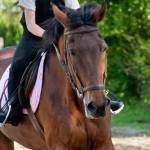Hypoxic Training Improves Fitness in Horses

If you feel your horse’s training has reached a plateau but you’re not competing at the level you hoped to, new research* supports the theory that hypoxic training can help improve fitness.
“Hypoxic training involves exercising in environments with oxygen levels that are lower than usual. Normal room air contains approximately 20% oxygen, whereas hypoxic training occurs when the athlete inhales lower levels of oxygen—about 15%,” explained Kathleen Crandell, Ph.D., a nutritionist for Kentucky Equine Research (KER).
One way to engage in hypoxic training is through the use of training facilities at high altitudes that naturally have lower oxygen levels. Alternatively, commercially available masks can be used that deliver lower levels of oxygen to the horse during exercise.
While hypoxic training reportedly improves athletic performance in a variety of athletes (e.g., both endurance and short-distance), whether this technique can help improve performance in already fit athletes remains unclear. To help answer this question, one group of scientists recruited five fit Thoroughbred horses.
Fitness was assessed via VO2max levels, which refers to the maximum volume of oxygen an athlete can use while exercising. Athletes with higher V̇O2max levels are considered more fit and better able to perform prolonged aerobic exercise.
The Thoroughbreds selected for the study had already achieved a stable VO2max. Horses were equipped with masks delivering 15% oxygen and trained on a treadmill for three weeks. Key findings of the study included:
- V̇O2max significantly increased after three weeks of hypoxic training even though all-out training in normal oxygen levels had not increased V̇O2max; and
- Total running distance increased 12% after hypoxic training, but this difference did not reach statistical significance.
These findings prompted the researchers to conclude that “hypoxic training may increase V̇O2max even though it is not increased by normoxic training in well-trained horses [on room air with normal oxygen levels], at least for the durations of time evaluated in this study. Training while breathing hypoxic gas may have the potential to enhance normoxic performance of Thoroughbred horses.”
“Regardless of which training methods you implement, be sure to protect the health of your horse’s respiratory and musculoskeletal systems,” advised Crandell. “KER offers several joint supplements, including KER•Flex, with chondroitin sulfate and glucosamine hydrochloride, and Synovate HA with high-molecular weight hyaluronic acid.”
In addition, look for EO•3, a marine-derived source of both DHA and EPA that supports joint and respiratory health.
Australian horse owners should look for these research proven supplements.
*Ohmura, H., K. Mukai, Y. Takahashi, et al. 2017. Hypoxic training increases maximal oxygen consumption in Thoroughbred horses well-trained in normoxia. Journal of Equine Veterinary Science. 28(2):41-45.








